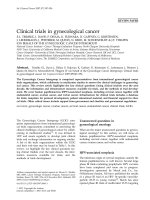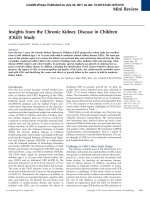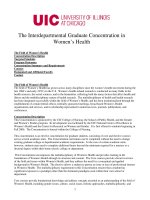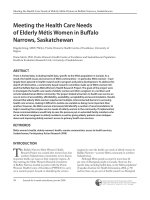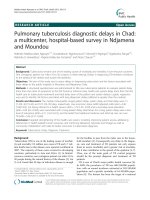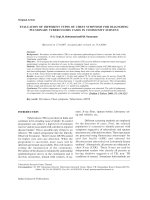Clinical Cases in Restorative & Reconstructive Dentistry_2 potx
Bạn đang xem bản rút gọn của tài liệu. Xem và tải ngay bản đầy đủ của tài liệu tại đây (40.21 MB, 254 trang )
221
8
Complete Implant - Supported Restorations
Clinical Cases in Restorative & Reconstructive Dentistry, Gregory J. Tarantola, © 2010 Blackwell Publishing Ltd.
Case 1 Complete implant - supported maxillary reconstruction — transitioning the anterior teeth from
tooth - supported to implant - supported
Case 2 Complete maxillary nonremovable restoration supported by 6 implants converted from a
complete removable restoration on 4 implants
Case 3 Complete implant - supported nonremovable maxillary and mandibular reconstructions; transi-
tioning from natural teeth that were not predictably restorable
Case 4 Maxillary extractions, immediate implant placement, immediate loading, and complete nonre-
movable zirconia restoration with pink porcelain
Case 5 Mandibular implant bar – supported full removable denture converted to a nonremovable resto-
ration to improve comfort of the neutral zone and phonetics
222 Clinical Cases in Restorative & Reconstructive Dentistry
SUMMARY OF EXAMINATION AND DIAGNOSIS
Dentition
Endodontic and structural failure 6, 7, 10, 11
Guarded but maintainable condition of lower
anterior teeth
Posterior implants and restorations are accept-
able and do not need to be changed.
Periodontium
Stable
TMJ s
Right Piper 3B
Left Piper 3B
Both can be superiorly compressed with no sign
of tension or tenderness.
Muscles
Slight lateral and medial pterygoid palpation
discomfort
Occlusion
Interferences and slide when condyles are in
ACP
Aesthetics
Reverse smile of upper anteriors
Chapter 8 Case 1
Complete implant - supported maxillary reconstruction —
transitioning the anterior teeth from tooth - supported to
implant - supported
Today ’ s dentistry gives us the opportunity to transition
a failing tooth - supported restoration to an implant - sup-
ported solution. Patient circumstances often necessi-
tate a segmental approach rather than changing
everything at once. Before we make this decision, we
must evaluate thoroughly and verify that the form and
function of what will not be changed is acceptable or
can be made acceptable with equilibration and reshap-
ing alone.
This patient has had a posterior screw - retained
implant - supported restoration for many years. Although
a much better looking restoration could be done, the
one she had was acceptable to her, it was healthy,
THE 10 DECISIONS
1. TMJ Diagnosis
Treat to a guided adapted centric posture.
2. Vertical Dimension
Acceptable; maintain.
3. Lower Incisal Edge
Acceptable; just smooth and polish.
4. Upper Incisal Edge
Lengthen upper central incisors 1.5 – 2.0 mm.
5. Centric Stops
Defi nitive centric stops posteriorly with
equilibration
Defi nitive centric stops anteriorly with restoration
6. Anterior Guidance
Acceptable, it will steepen slightly with new
incisal edge position.
7. Curve of Spee
Acceptable
8. Curve of Wilson
Slight reverse Curve of Wilson. Correct as much
as possible with reshaping. It discludes com-
pletely even though not “ ideal looking. ”
9. Cusp/Fossa Angle
Acceptable
10. Aesthetic Plane
Improve reverse anterior smile line.
Posterior aesthetic plane is acceptable.
and it functioned well. The upper anterior teeth sup-
porting a fi xed restoration were hopeless and the plan
was to transition to an implant - supported restoration.
The lower anterior teeth supporting a fi xed restoration
have a guarded prognosis but will be maintained for as
long as possible. The functional landmarks were
acceptable, so there was no occlusal compromise.
CHAPTER 8 COMPLETE IMPLANT-SUPPORTED RESTORATIONS
Clinical Cases in Restorative & Reconstructive Dentistry 223
Figure 8.1.1. Preoperative panoramic. Upper anterior teeth
are hopeless. Lower anterior teeth guarded but maintainable
for the short term. Posterior implants and restorations
acceptable.
SUMMARY OF TREATMENT SEQUENCE
Appointment Treatment Completed
1 Surgeon to remove 6, 7, 10,
11
Immediate implant placement
Removable provisional
immediately placed
2 Time to heal and integrate
3 Equilibrate posterior teeth to
eliminate slide
Implant level impressions
4 Place custom abutments and
fi xed provisional.
Evaluate changes in form and
function.
5 Impressions of abutments
6 Place defi nitive restoration.
SUMMARY OF TREATMENT PLAN
Dentition
Remove 6, 7, 10, 11.
Immediate implant placement
Delayed restoration
Periodontium
Professional maintenance
TMJ s
No treatment is needed other than correct bite
engineering.
Muscles
No treatment is needed other than correct bite
engineering.
Occlusion
Equilibrate posteriorly; improve anterior guidance
with new restoration.
Aesthetics
Correct reverse smile of upper anterior, increase
length of centrals
Figure 8.1.2. Preoperative smile photograph, reverse smile
evident.
Figure 8.1.3. Preoperative retracted views.
224
Figure 8.1.4. Preoperative lingual views. Old but acceptable
screw - retained posterior implant - supported restorations. They
have been in place over 10 years.
Figure 8.1.5. Preoperative occlusal view.
Figure 8.1.6. Trial equilibrated articulated diagnostic casts. All
parameters of static and dynamic occlusion can be fulfi lled.
Maxillary anterior teeth will be lengthened.
Figure 8.1.7. Implant level impressions.
Figure 8.1.8. Custom abutments and soft tissue cast.
Implants are deep subgingivally. Custom abutment brings
restoration fi nish line to tissue level.
Figure 8.1.9. Putty index of verifi ed provisionals and
defi nitive restoration verifi ed.
Figure 8.1.10. Finished result, reverse smile improved.
CHAPTER 8 COMPLETE IMPLANT-SUPPORTED RESTORATIONS
Clinical Cases in Restorative & Reconstructive Dentistry 225
Figure 8.1.11. Posttreatment panoramic radiograph. Lower
anteriors still maintained as of 8 years posttreatment
completion of upper anterior.
CHAPTER 8 CASE 1 KEY POINTS
If the top of the implant is very deep, use a
two - piece or custom abutment to bring the
fi nish line of the restoration closer to the free
margin of the tissue.
Consider cemented restorations as the
treatment of choice over screw - retained
restorations.
226 Clinical Cases in Restorative & Reconstructive Dentistry
Chapter 8 Case 2
Complete maxillary nonremovable restoration supported by
6 implants converted from a completed removable
restoration on 4 implants
The patient in this case study had recently completed
a restoration from another dentist but she was not
pleased. She had expected a nonremovable restoration
but the defi nitive dentistry was a removable denture
supported by 4 implants. She had some very specifi c
ideas about the aesthetics she desired, so additional
time was spent before any treatment was initiated to
confi rm that her expectations could be met.
THE 10 DECISIONS
1. TMJ Diagnosis
Treat to a guided, verifi able adapted centric
posture.
2. Vertical Dimension
Determined by traditional denture techniques
with 2 mm of freeway space
3. Lower Incisal Edge
Acceptable; just smooth and polish.
4. Upper Incisal Edge
Current restoration is acceptable.
5. Centric Stops
Simultaneous, equal intensity centric stops in the
adapted centric posture arc of closure
6. Anterior Guidance
Determined by fi nalized upper and lower incisal
edge position
7. Curve of Spee
Lower needs minor reshaping to improve.
8. Curve of Wilson
Lower needs minor reshaping to improve.
9. Cusp/Fossa Angle
Shallower than the anterior guidance disclusive
angle
10. Aesthetic Plane
Create an upper posterior aesthetic plane that is
consistent with the upper incisal edge position
and with pleasing buccal profi les.
SUMMARY OF EXAMINATION AND DIAGNOSIS
Dentition
4 upper implants, unacceptable denture
Lower teeth have many restorations, recently
completed orthodontics.
Periodontium
Lower is guarded to hopeless.
TMJ s
Right side Piper 2
Left side Piper 2
Both can be superiorly compressed comfortably.
Muscles
Lateral pterygoids uncomfortable to palpation
Occlusion
Lower functional landmarks are acceptable or
easily modifi able.
Aesthetics
Incisal edge position is acceptable but size,
proportion, and color are not.
CHAPTER 8 COMPLETE IMPLANT-SUPPORTED RESTORATIONS
Clinical Cases in Restorative & Reconstructive Dentistry 227
SUMMARY OF TREATMENT SEQUENCE
Appointment Treatment Completed
1 Removable provisional to be
used as a diagnostic wax - up to
verify that expectations can be
met
2 Once (and if) approved, place
2 more posterior implants.
3 Heal and integrate.
4 Implant level impressions for
custom abutments
5 Place abutments and retrofi t
previously approved
provisional.
6 Evaluate and modify
provisional.
7 Defi nitive impression and bite
records
8 Place upper defi nitive
restoration.
9 Plan lower when appropriate.
SUMMARY OF TREATMENT PLAN
Dentition
Place 2 more implants.
Nonremovable implant - supported restoration
Periodontium
Maintain lower by periodontist until patient is
able to proceed with an implant solution.
TMJ s
No treatment is needed other than to correct
occlusal engineering.
Muscles
No treatment is needed other than correct
occlusal engineering.
Occlusion
Simultaneous equal intensity contacts in centric
relation and anterior guidance on anterior teeth
Aesthetics
Idealize form, contour, and proportions. Gingiva
will be simulated with pink porcelain.
Figure 8.2.1. Pretreatment anterior and lateral smile
photographs. Restoration is a removable complete implant -
retained denture. She desires a nonremovable solution.
Incisal edge position is acceptable but she feels teeth are
too large. A nonacrylic denture material was used (Valplast)
because of a suspected acrylic allergy.
Figure 8.2.2. Pretreatment anterior and lateral retracted
photographs. The denture fl ange was shortened because of
path of insertion problems due to facially angulated anterior
implant placement. Orthodontics was completed on the
mandibular resulting in acceptable functional landmarks. This
will allow upper dentistry to be completed without treating
lower at this point. Patient circumstances necessitated lower
treatment being delayed.
228
Figure 8.2.3. Pretreatment maxillary occlusal photographs.
The two most posterior implants have Locator abutments for
denture retention. The two most anterior implants have
healing caps because severe angulation prevented their use
as an abutment. Several other teeth were recently extracted.
Figure 8.2.4. Pretreatment panoramic radiograph illustrating
major periodontal issues with the mandibular teeth. Patient is
fully aware of the diagnosis.
Figure 8.2.6. Lateral smile photographs of the provisional in
Figure 8.2.5 . Lip support was acceptable, verifying that a
denture fl ange is not necessary and that a nonremovable
approach is possible.
Figure 8.2.7. Anterior and lateral retracted photographs of
the provisional in Figure 8.2.5 . It simply sets on the current
abutment situation for diagnostic evaluation.
Figure 8.2.8. Anterior and lateral smile photographs of a
second attempt at a diagnostic provisional. Patient
comments about fi rst diagnostic provisional were
incorporated into this second attempt. The teeth were made
narrower mesiodistally, and pink acrylic to simulate gingival
was used to make the teeth appear smaller incisogingivally.
This fulfi lled her aesthetic expectations.
Figure 8.2.5. Photographs of a diagnostic provisional made
on the initial articulated diagnostic casts. This is not attached
to the implants but sets on the current abutments and is
stable and retentive enough for evaluation. Although incisal
edge position was acceptable, the patient did not like the
width and incisal - gingival length of the teeth.
229
Figure 8.2.9. Anterior and lateral retracted photographs of
the second diagnostic provisional. Current mesiodistal
implant position aligned favorably with the maxillary lateral
incisors. The pink acrylic fi ts to the edentulous ridge like a
pontic; there is not a denture fl ange. Since this was
acceptable to the patient, the plan of a nonremovable
restoration was indeed possible and would achieve
acceptable results. Two more posterior implants were
needed for the support necessary to make a nonremovable
restoration. All this was done prior to making any irreversible
changes to the patient. She simply continued to wear her
current removable prosthesis. It was extra work but well
worth the effort in gaining assurance that patient
expectations could be met.
Figure 8.2.11. Lateral smile photograph of the second
provisional confi rming acceptable lip support.
Figure 8.2.10. Maxillary occlusal photograph after placement
of two more implants and fi nalized abutments. The two
anterior abutments are 8 mm solid healing abutments
prepped and used as fi nal abutments. A two - piece abutment
could not be used because the screw head would have been
totally obliterated to gain a path of insertion in the facially
inclined implants. This creative solution allowed these
implants to be used as abutments.
Figure 8.2.12. Anterior and lateral retracted photographs of
the cemented nonremovable provisional. The second
diagnostic provisional was used as a defi nitive fi xed
provisional over the fi nal abutments.
Figure 8.2.13. Anterior and lateral smile photographs of the
defi nitive restoration using pink porcelain to simulate the
gingival. Note similarities with the provisional restoration.
PART 2 CASE STUDIES
230 Clinical Cases in Restorative & Reconstructive Dentistry
Figure 8.2.14. Anterior and lateral retracted photographs of
the cemented defi nitive restoration. The second molars are
cantilevers. The entire restoration is supported by the six
implants. The patient was pleased with the fi nal result and
very happy to have a nonremovable restoration — her primary
desire and expectation.
CHAPTER 8 CASE 2 KEY POINTS
In totally edentulous cases, a nonremovable
restoration is possible if a fl ange is not
needed for lip support.
Time spent at the diagnostic phase making
even multiple “ preview ” restorations is never
wasted time.
Even if the opposing arch may not be treated
right away, make needed functional or land-
mark changes with reshaping and composite
additions as needed.
Clinical Cases in Restorative & Reconstructive Dentistry 231
Chapter 8 Case 3
Complete implant - supported nonremovable maxillary and
mandibular reconstructions; transitioning from natural
teeth that were not predictably restorable
SUMMARY OF EXAMINATION AND DIAGNOSIS
Dentition
Not predictably restorable
Periodontium
No major disease
TMJ s
Right side Piper 2
Left side Piper 2
Both can be compressed without discomfort.
Muscles
Lateral pterygoids are uncomfortable to testing.
Occlusion
Interferences in the arc of closure to maximum
intercuspation
End - to - end anterior tooth - to - tooth relationship
does not disclude posterior teeth.
Aesthetics
Position, proportion, contour.
The gentleman in this case study had teeth that were
not predictably restorable, and he understood and was
willing to go through the project of transitioning from
his natural secondary dentition to a nonremovable
implant - supported reconstruction. The key is to save
enough strategically placed natural teeth to support a
nonremovable provisional. This gives the patient a
better representation of the fi nal result and also
eliminates any pressure that a removable provisional
might pose on the surgical sites.
THE 10 DECISIONS
1. TMJ Diagnosis
Treat to a guided, verifi able centric relation.
2. Vertical Dimension
Open slightly.
3. Lower Incisal Edge
Maintain incisal edge position.
4. Upper Incisal Edge
Increase length and move facially to improve
overbite and overjet relationship.
5. Centric Stops
Simultaneous, equal intensity centric stops in the
centric relation arc of closure
6. Anterior Guidance
Shallow due to minimal overbite.
7. Curve of Spee
Shallow and fl at due to shallow anterior guidance
8. Curve of Wilson
Verify that upper buccal and lower lingual cusps
do not interfere in the functional and parafunc-
tional range of motion.
9. Cusp/Fossa Angle
Shallower than the anterior guidance disclusion
angle
10. Aesthetic Plane
Create an upper posterior aesthetic plane that is
consistent with the upper incisal edge position
and with pleasing buccal profi les.
PART 2 CASE STUDIES
232 Clinical Cases in Restorative & Reconstructive Dentistry
SUMMARY OF TREATMENT PLAN
Dentition
Remove all natural teeth.
8 implants upper
6 implants lower
Maxillary and mandibular nonremovable
reconstructions
Periodontium
Grafting as needed in conjunction with implant
placement
TMJ s
No treatment is needed other than to correct
occlusal engineering.
Muscles
No treatment is needed other than to correct
occlusal engineering.
Occlusion
Simultaneous, equal intensity centric stops in the
centric relation arc of closure, 2 mm overbite
with anterior guidance on anterior teeth
Aesthetics
Idealize form, contour, proportion.
Use pink porcelain on maxillary reconstruction for
more ideal length of teeth.
SUMMARY OF TREATMENT SEQUENCE
Appointment Treatment Completed
1 Prepare lower third molars and
cuspids for provisional
abutments.
Prepare maxillary second
molars and left central incisor
for provisional abutments.
To surgeon for lower
extractions and implant
placement, maxillary
extractions, and bone grafts
2 Mandibular implant level
impression
CAT scan with radiopaque
maxillary surgical stent
3 Surgeon to extract 4 remaining
lower teeth
Surgeon to place 8 maxillary
implants
To restorative dentist to place
mandibular abutments and
new provisional
Reline and recement upper
provisional.
4 Maxillary implant level
impressions
Mandibular impressions of
abutments for defi nitive
restoration
5 To surgeon to extract remaining
maxillary teeth
To restorative dentist to place
defi nitive mandibular restoration
Place maxillary abutments and
new provisional.
6 Impressions for defi nitive
maxillary restoration
7 Place maxillary restoration.
8 Follow - up and bite splint
233
Figure 8.3.1. Pretreatment smile and retracted photographs
suggesting a multitude of problems.
Figure 8.3.2. Pretreatment buccal occluded and occlusal
photographs suggesting functional occlusal plane problems,
anterior guidance problems, and structural problems.
Figure 8.3.3. Pretreatment panoramic radiograph. The very
few teeth that might be savable do not lend themselves to a
comprehensive plan. In fact if they were kept, they would
compromise the result, adding uncertainty to the longevity.
Figure 8.3.4. Photographs of the initial diagnostic wax - up
illustrating functional and aesthetic changes. This could be
considered a “ starting point ” wax - up because there will be
time and multiple provisionals to make modifi cations and
refi nements.
Figure 8.3.5. Posttreatment photographs after the fi rst phase
of treatment. The maxillary second molars and left central
incisor support a provisional restoration. Even though these
abutments will eventually be lost, they are carefully built up
with foundation restorations and prepared. The maxillary
implants could not be immediately placed, so extractions and
bone grafts were done. The mandibular third molars and
cuspids retain a provisional. The implants were immediately
placed but not loaded. Note how the maxillary central
incisors were “ moved ” to close the diastema. The maxillary
left central incisor abutment is actually between the maxillary
left central and lateral incisors. Pink acrylic was used to
simulate a papilla and give the illusion of correctly placed
teeth. Doing this will allow for correct placement of the
implant in the maxillary right central incisor position.
234
Figure 8.3.6. Planning for the second phase. A surgical stent
with gutta percha is used for a CAT scan analysis so that the
surgeon could evaluate which sites would work best for
implants to be placed in positions correct for the end result
tooth position. Eight sites were chosen.
Figure 8.3.7. The planning for the second phase included a
mandibular implant level impression, top left. The correct
abutments were selected and prepared on an implant cast,
top right. An impression was made of this implant cast,
lower left, and another all stone cast prepared, lower right.
This cast will be used to fabricate a provisional.
Figure 8.3.8. Articulated diagnostic casts were made of the
fi rst provisional and modifi cations were made to the contours
of the mandibular in preparation for a new provisional.
Figure 8.3.9. Top: photograph of a Ribbond scaffolding
attached to the preparations with light - cured fl owable
composite resin. The acrylic is processed over this
scaffolding, and a fi nal check is made on the articulated
implant cast (bottom).
235
Figure 8.3.10. Photographs after the second phase. The
patient appoints with the surgeon fi rst to place the 8
maxillary implants and extract the 4 remaining mandibular
teeth. The patient returned immediately to the offi ce to place
the mandibular abutments and new provisional and to refi t
the maxillary provisional over the implant healing caps. The
implants were not immediately loaded.
Figure 8.3.11. After time for complete healing, the next
phase was begun. A maxillary implant level impression was
made along with a mandibular impression of the implant
abutments. Maxillary implant abutments were selected and a
new provisional was made, following the same procedure as
for the mandibular. The mandibular defi nitive casts were sent
to the technician for fabrication. These photographs illustrate
the new maxillary provisional on the implant abutments and
the defi nitive mandibular implant - supported restoration.
Figure 8.3.12. After enough time for healing of the 3
remaining maxillary extractions, impressions were made for
the defi nitive maxillary implant - supported restoration. Top
left: photograph of the maxillary provisional restoration with
incisal edge/aesthetic plane putty index. Areas planned for
pink porcelain are also outlined. Bottom left: the defi nitive
restoration checked with the putty index. Top right: the
defi nitive restoration on the solid cast to verify tissue
contours. Bottom right: all concavities emerging from the
implant abutment fi nish lines are fi lled in to create straight -
to - convex contours for tissue support and cleanability.
Figure 8.3.13. Lateral smile and retracted photographs of the
defi nitive restoration. Overbite/overjet was increased to
approximately 2 mm.
PART 2 CASE STUDIES
236 Clinical Cases in Restorative & Reconstructive Dentistry
Figure 8.3.14. Panoramic radiograph of the completed
maxillary and mandibular restorations. The slight marginal
gap on the maxillary left last abutment was deemed to be
clinically acceptable.
CHAPTER 8 CASE 3 KEY POINTS
When using natural teeth for provisional
abutments, carefully prepare and build up
abutments and use a straight fi nish line for
maximum resistance and retention form.
Ribbond reinforced provisionals are extremely
durable for long term provisionals.
Clinical Cases in Restorative & Reconstructive Dentistry 237
SUMMARY OF EXAMINATION AND DIAGNOSIS
Dentition
Maxillary and mandibular are hopeless.
Periodontium
Maxillary and mandibular are hopeless.
TMJ s
Right side Piper 2
Left side Piper 2
Both can be compressed without discomfort.
Muscles
Slight lateral pterygoid discomfort to testing
Occlusion
Interferences in the arc of closure to maximum
intercuspation
Excessive Curve of Spee
Aesthetics
Form, contour, proportion, excessive length
Chapter 8 Case 4
Maxillary extractions, immediate implant placement,
immediate loading, and complete nonremovable zirconia
restoration with pink porcelain
The patient in this case study has a failing maxillary
and mandibular reconstruction with both dental implant
and natural tooth abutments. The maxillary is the more
urgent arch because there are currently no maxillary
right posterior teeth. The patient desires a nonremov-
able implant - supported reconstruction. The mandibular
dentition is hopeless and needs the same treatment;
however, her circumstances dictate that only the
maxillary will be addressed at this time. The mandibu-
lar functional landmarks can be modifi ed for a good
result.
THE 10 DECISIONS
1. TMJ Diagnosis
Treat to a guided, verifi ed centric relation.
2. Vertical Dimension
No need to change
3. Lower Incisal Edge
Smooth and polish for an even plane.
4. Upper Incisal Edge
No need to change
5. Centric Stops
Simultaneous, equal intensity centric stops in the
centric relation arc of closure
6. Anterior Guidance
Determined by fi nalized upper and lower incisal
edge position.
7. Curve of Spee
Reshape mandibular to fl atten and idealize.
8. Curve of Wilson
Verify that upper buccal and lower lingual cusps
do not interfere in the functional and parafunc-
tional range of motion.
9. Cusp/Fossa Angle
Shallower than the anterior guidance disclusive
angle
10. Aesthetic Plane
Create an upper posterior aesthetic plane that is
consistent with the upper incisal edge position
and with pleasing buccal profi les.
PART 2 CASE STUDIES
238 Clinical Cases in Restorative & Reconstructive Dentistry
Figure 8.4.1. Pretreatment photograph illustrating a hopeless
maxillary and mandibular dentition.
Figure 8.4.2. Pretreatment panoramic radiograph. The two
maxillary left implants and the two most posterior mandibular
implants are serviceable.
SUMMARY OF TREATMENT SEQUENCE
Appointment Treatment Completed
1 Maxillary extractions
Immediate placement of 8
implants
Place 8 temporary abutments.
Use 2 implants currently in place.
Nonremovable provisional
2 Heal and integrate.
3 Implant level impression
4 Place defi nitive abutments and
new provisional.
Defi nitive impressions
5 Place defi nitive maxillary
reconstruction.
6 Begin mandibular treatment as
circumstances permit.
SUMMARY OF TREATMENT PLAN
Dentition
Maxillary extractions
Immediate implant placement
Utilize 2 current implants upper left.
Immediate placement of 8 implants
Immediate provisional with temporary abutments
Periodontium
Transition to implants
TMJ s
No treatment is needed other than correct
occlusal engineering.
Muscles
No treatment is needed other than correct
occlusal engineering.
Occlusion
Simultaneous, equal intensity centric stops in the
centric relation arc of closure
Correct Curve of Spee.
Anterior guidance on anterior teeth
Aesthetics
Improve color, size, proportion.
Use pink porcelain to control tooth length.
Figure 8.4.3. Anterior retracted photograph approximately 1
month postsurgery. The maxillary teeth were extracted and 8
dental implants immediately placed. This decision was made
by the oral surgeon based on analysis of the CAT scan.
Temporary plastic implant abutments were placed and
prepared and an alginate impression was made. The
prefabricated provisional was relined over the cast of the
temporary implant abutment preparations and then refi ned
intraorally. The mandibular restorations were reshaped and
contoured to create a more ideal incisal plane, Curve of
Spee, and Curve of Wilson.
Figure 8.4.4. Postsurgery panoramic radiograph of the
maxillary dental implants and temporary abutments.
CHAPTER 8 COMPLETE IMPLANT-SUPPORTED RESTORATIONS
Clinical Cases in Restorative & Reconstructive Dentistry 239
Figure 8.4.5. Photograph of the new provisional after the
defi nitive implant abutments were placed. An implant level
impression was made, the implant abutments were
modifi ed, and the provisional was fabricated as illustrated in
Figures 8.3.7 – 8.3.9 .
Figure 8.4.6. Defi nitive impressions were made of the
implant abutments after they were secured in place. From
this point, the case was handled just like a crown and bridge
case. These photographs illustrate the 14 - unit Zirconia
framework.
Figure 8.4.7. Anterior and lateral smile photographs and anterior and lateral retracted photographs of the completed restoration.
All areas are easily cleanable with brushes and fl oss. The restoration is placed with a soft, retrievable cement.
CHAPTER 8 CASE 4 KEY POINTS
Immediately loaded dental implants can be a
predictable approach in select circumstances.
Pink porcelain can be used to simulate tissue
if a fl ange is not needed for lip support.
Zirconia can be used for an extensive fi xed
framework.
240 Clinical Cases in Restorative & Reconstructive Dentistry
Chapter 8 Case 5
Mandibular implant bar – supported full removable denture
converted to a nonremovable restoration to improve
comfort of the neutral zone and phonetics
SUMMARY OF EXAMINATION AND DIAGNOSIS
Dentition
Unacceptable mandibular implant bar – supported
full denture on 4 implants
Periodontium
Current implants are healthy.
TMJ s
Right side Piper 3B
Left side Piper 3B
Both can be compressed without discomfort.
Muscles
No discomfort to testing
Occlusion
Denture occlusion is not coincident to the arc of
closure.
Aesthetics
Insuffi cient maxillary incisor display
Lower denture interferes with neutral zone.
The patient in this case study recently had her implant
bar – supported restoration completed on 4 implants.
The fi t and stability was acceptable, but the restoration
felt bulky and interfered with the tongue during
phonetics. With the placement of 2 more implants, a
new nonremovable restoration was completed.
THE 10 DECISIONS
1. TMJ Diagnosis
Treat to a guided, verifi able adapted centric
posture.
2. Vertical Dimension
Acceptable for the facial asthetics of a full
denture patient
3. Lower Incisal Edge
Acceptable
4. Upper Incisal Edge
Increase length 1.5 mm.
5. Centric Stops
Simultaneous, equal intensity centric stops on
the posterior teeth in the adapted centric posture
arc of closure; anterior teeth slightly out of
occlusion
6. Anterior Guidance
Typical full denture anterior guidance; starts on
posterior teeth and transitions to a shallow, fl at,
smooth anterior tooth disclusion angle
7. Curve of Spee
Anterior reference — cuspids
Posterior reference — halfway on retromolar pad
8. Curve of Wilson
Verify that upper buccal and lower lingual cusps
do not interfere in the functional and parafunc-
tional range of motion.
9. Cusp/Fossa Angle
Approximately the same as the anterior guidance
disclusion angle
10. Aesthetic Plane
Create an upper posterior aesthetic plane that is
consistent with the upper incisal edge position
and with pleasing buccal profi les.
CHAPTER 8 COMPLETE IMPLANT-SUPPORTED RESTORATIONS
Clinical Cases in Restorative & Reconstructive Dentistry 241
SUMMARY OF TREATMENT SEQUENCE
Appointment Treatment Completed
1 Remove bar.
To surgeon for 2 more
implants
Back to offi ce to modify
underside of bar and replace —
use as provisional during
healing
2 Remove current abutments.
Implant level impression
Fabricate implant cast in
offi ce.
Modify stock abutments.
Fabricate provisional on
duplicate of implant cast.
Place abutments intraorally.
Defi nitive impressions
Upper full denture impression
and bite records. A duplicate
of her current maxillary
denture was used as an
impression tray and bite record
because it was acceptable
other than increasing maxillary
incisor length 1.5 mm.
Place nonremovable
provisional.
NOTE: Patient traveled 4
hours, so this lengthy
appointment was carefully
planned and prearranged.
3 Place defi nitive mandibular
nonremovable restoration.
Place new maxillary denture.
4 Future: plan for implant -
supported maxillary full
denture.
SUMMARY OF TREATMENT PLAN
Dentition
Place 2 more implants.
Fabricate a nonremovable 12 - unit restoration.
Periodontium
Place 2 implants.
No additional treatment is needed.
TMJ s
No treatment is needed other than correct
occlusal engineering.
Muscles
No treatment is needed other than correct
occlusal engineering.
Occlusion
Simultaneous, equal intensity centric stops on
the posterior in the adapted centric posture arc
of closure; anterior teeth slightly out of occlu-
sion; anterior guidance starts on posterior teeth
and then transitions to anterior teeth — typical full
denture anterior guidance.
Aesthetics
Create an upper posterior aesthetic plane that is
consistent with the upper incisal edge position
and with pleasing buccal profi les.
242
Figure 8.5.1. Pretreatment condition. Top left: implants with
abutments for screw - retained bar. Top right: implant -
supported bar screwed in place on the implant abutments.
Bottom left: pretreatment radiograph of implants and bar
suggesting well integrated implants. Bottom right: underside
of removable prosthesis with metal reinforcement and
attachments on distal extension bar and lingual button. The
patient disliked the bulkiness of the prosthesis, which
interfered with phonetics. Her desire was to have a
nonremovable restoration as close to natural teeth as
possible. The oral surgeon, after CAT scan analysis reported
that 2 more implants could be placed distally and that these
6 implants could support a nonremovable restoration. A
diagnostic wax - up revealed that teeth and pontics lined up
well over the implants as they are currently positioned.
Figure 8.5.2. Top left: photograph after the 2 additional
implants were placed and new abutments prepared for a
nonremovable restoration. Top right: provisional
nonremovable restoration in place. It is always desirable to
make a provisional as close to the defi nitive as possible. This
minimizes unmet expectations. Middle photographs: buccal
and lingual putty indices made over the articulated cast of
the provisional restoration. Bottom photographs: putty
indices in place on the solid cast of the defi nitive implant
abutments. This laboratory communication will guide the
technician to make a defi nitive restoration as close to the
provisional restoration as possible, which the patient
approved in terms of contours, aesthetics, phonetics,
comfort, and function.
CHAPTER 8 COMPLETE IMPLANT-SUPPORTED RESTORATIONS
Clinical Cases in Restorative & Reconstructive Dentistry 243
Figure 8.5.3. Smile and retracted photographs of the completed restoration; a new maxillary complete removable denture and a
mandibular 12 - unit nonremovable implant - supported restoration.
Figure 8.5.4. Occlusal photograph of the completed
mandibular restoration suggesting natural size, contours, and
position. The patient ’ s expectations were exceeded. When
her circunstances permit, she will begin a treatment plan for
an implant - retained maxillary denture.
CHAPTER 8 CASE 5 KEY POINTS
Full denture patients get the same complete
examination with articulated diagnostic casts
that the dentate patient gets.
The diagnostic wax - up will confi rm how
desired tooth position relates to current
implant position.
245
9
Orthognathics
Clinical Cases in Restorative & Reconstructive Dentistry, Gregory J. Tarantola, © 2010 Blackwell Publishing Ltd.
Case 1 Severe anterior open bite corrected with maxillary - only orthognathics and occlusal therapy with
upper incisor restorations
Case 2 Mandibular orthognathic surgery and chin implant; managing a temporomandibular disorder
during treatment; posterior restorative dentistry including implants
Case 3 Maxillary and mandibular orthognathic surgery with chin advancement; prerestorative occlusal
therapy with equilibration and composite additions
See also:
Chapter 16 Case 1 Severe anterior overjet handled with occlusal/restorative treatment in lieu of
orthognathics; muscular component of a temporomandibular disorder also managed
